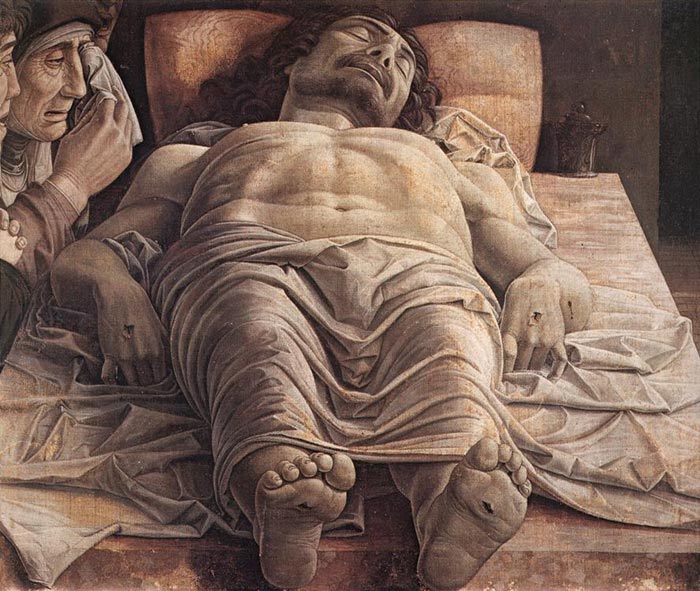 |
Andrea Mantegna, The Lamentation over the Dead Christ, Pinacoteca di Brera, Milan |
| Andrea Mantegna, The Lamentation over the Dead Christ |
The Lamentation over the Dead Christ is a c. 1480 painting by the Italian Renaissance artist Andrea Mantegna.[1] While the dating of the piece is debated, is generally believed to have been completed between 1457 and 1501.[2] It portrays the body Christ supine on a marble slab. He is watched over by the Virgin Mary and St. John, who are weeping for his death. It is typical of Mantegna's art that the simple window-like framing of the confined space in this painting architecturally defines it as the cold and dismal cell of a morgue. Looking in we see an almost monstrous spectacle: a heavy corpse, seemingly swollen by the exaggerated foreshortening. At the front are two enormous feet with holes in them; on the left, some tear-stained, staring masks. But another look dissipates the initial shock, and a rational system can be discerned under the subdued light. The face of Christ, like the other faces, is seamed by wrinkles, which harmonize with the watery satin of the pinkish pillow, the pale granulations of the marble slab and the veined onyx of the ointment jar. The damp folds of the shroud emphasize the folds in the tight skin, which is like torn parchment around the dry wounds. All these lines are echoed in the wild waves of the hair. Mantegna's realism prevails over any esthetic indulgence that might result from an over-refined lingering over the material aspects of his subject. His realism is in turn dominated by an exalted poetic feeling for suffering and Christian resignation. Mantegna's creative power lies in his own interpretation of the "historic," his feeling for spectacle on a small as well as a large scale. Beyond his apparent coldness and studied detachment, Mantegna's feelings are those of a historian, and like all great historians he is full of humanity. He has a tragic sense of the history and destiny of man, and of the problems of good and evil, life and death. |
|
|
| Art in Tuscany | Giorgio Vasari's Lives of the Artists | Andrea Mantegna Giorgio Vasari | Le vite de' più eccellenti architetti, pittori, et scultori italiani, da Cimabue insino a' tempi nostri | Andrea Mantegna |
